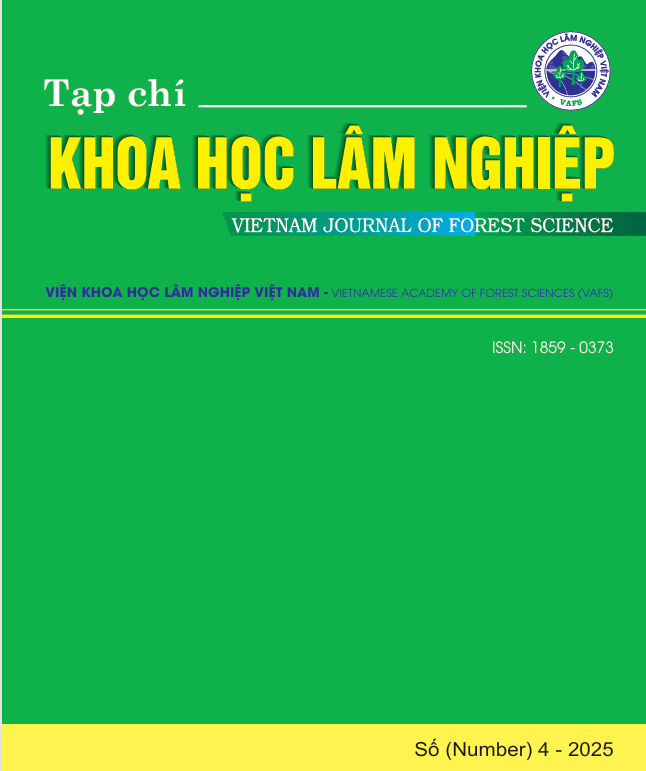NGHIÊN CỨU XỬ LÝ LÀM TĂNG KHẢ NĂNG ỔN ĐỊNH KÍCH THƯỚC CỦA GỖ CAO SU (Hevea brasiliensis)
DOI:
https://doi.org/10.70169/VJFS.1086Từ khóa:
xử lý biến tính, gỗ cao su, kali silicateTóm tắt
Nghiên cứu xử lý gỗ Cao su (Hevea brasiliensis) nhằm tăng cường khả năng ổn định kích thước của gỗ sau xử lý Kali Silicate (K2SiO3). Thực nghiệm gỗ Cao su với Kali Silicate (K2SiO3) các cấp nồng độ và thời gian xử lý khác nhau. Sau đó kiểm tra độ dãn nở của gỗ Cao su (Hevea brasiliensis) theo các chiều thớ gỗ. Kết quả cho thấy nồng độ và thời gian xử lý là hai yếu tố ảnh hưởng trực tiếp làm giảm độ dãn nở (trương nở) của gỗ Cao su, điều này làm cho gỗ có sự cải thiện đáng kể về tính chất vật lý. Kết quả tối ưu đạt được trên cơ sở thiết lập phương trình tương quan Gỗ Cao su với thông số nồng độ Kali silicate (K2SiO3) là X1 = 1,414(N = 27,07%) và thời gian xử lý là X2 = 0,348 (T = 3,348 (giờ) tỷ lệ dãn nở gỗ theo chiều tiếp tuyến là 2,9547% , mẫu đối chứng là 6,4813%, tỷ lệ dãn nở gỗ xuyên tâm là 1,0632% mẫu đối chứng là 4,1366% và tỷ lệ dãn nở gỗ dọc thớ là 0,0417%, mẫu đối chứng 0,6793%, với kết quả này cho thấy làm giảm độ dãn nở gỗ theo các chiều thớ có ý nghĩa quan trọng làm tăng khả năng ổn định kích thước gỗ Cao su.
Tài liệu tham khảo
1. Callum A.S. Hill, 2006. Wood Modification: Chemical, Thermal and Other Processes, Agricultural and Forest Sciences, University of Wales, Bangor.
2. Fuchs, W., 1928. Genuine lignin. I. Acetylation of pine wood. Berichte der Deutschen Chemischen Gesellschaft, 61B, 948-51. https://doi.org/10.1002/cber.19280610512
3. Jones, D., Kržišnik, D., Hočevar, M., Zagar, A., Humar, M., Popescu, C. M., ... & Sandberg, D., 2022. Evaluation of the Effect of a Combined Chemical and Thermal Modification of Wood though the Use of Bicine and Tricine. Forests, 13(6), 834. https://doi.org/10.3390/f13060834
4. Kumar, S., 1994. Chemical modification of wood. Wood and Fiber Science, 26, 270 /280. https://wfs.swst.org/index.php/wfs/article/view/1584
5. Lê Xuân Tình, 1998. Khoa học gỗ. Trường Đại học Lâm nghiệp, Việt Nam
6. Mariani, A.& Malucelli, G., 2022. Transparent Wood-Based Materials: Current State-of-the-Art and Future Perspectives. Materials , 15, 9069. https://doi.org/10.3390/ma15249069.
7. Nguyễn Cảnh, 1993. Qui hoạch thực nghiệm. Đại học Bách Khoa TP. Hồ Chí Minh, Việt Nam.
8. Roger M. Rowell, 2006. Chemical modification of wood: A short review, Wood Material Science and Engineering, University of Wisconsin, WI, USA, https://www.fpl.fs.usda.gov/documnts/pdf2006/fpl_2006_rowell006.pdf.
9. Roger, M. Rowell, 1991. Chemical modification of wood. In: D. N.-S. Hon and N. Shiraishi, eds., Handbook on wood and cellulosicmaterials. Marcel Dekker, Inc., New York. Ch. 15, p. 703 /756. https://www.academia.edu/49715913/Chemical_Modification_of_Wood
10. Stamm, A.J. and Hansen, L.A., 1937. Minimizing Wood Shrinkage and Swelling. Effect of Heating in Various Gases. Industrial and Engineering Chemistry, 29, 831-833.
https://doi.org/10.1021/ie50331a021
11. Suida, H. & Titsch, H., 1929. Chemistry of beech wood: Acetylation of beech wood and cleavage of the acetyl-beechwood. Berichte der Deutschen Chemischen Gesellschaft, 61B,1599 /1604.
12. Tarkow, H., Stamm, A. J. & Erickson, E. C. O., 1946. Acetylatedwood. Rep. 1593, USDA Forest Service, Forest ProductsLaboratory, Madison, WI, 29 pp.













